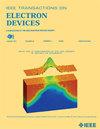Microwave Power Performance of Buffer-Free AlGaN/GaN MISHEMT With MOCVD Grown Ex Situ SiN
IF 2.9
2区 工程技术
Q2 ENGINEERING, ELECTRICAL & ELECTRONIC
引用次数: 0
Abstract
This work investigates the effect of ex situ MOCVD-grown SiNx gate dielectric and PECVD SiNx passivation layer on the microwave power performance of buffer-free AlGaN/GaN MISHEMT. We fabricated devices on a series of four samples diced from a 4 inch epi: first two samples had no gate dielectric while the latter two had upto 3 nm of ex situ SiNx as the gate dielectric. In each of the categories, one sample had baseline 100 nm SiNx passivation deposited under high frequency plasma conditions, while the other sample had 100 nm bilayer SiNx passivation. Devices had gate length ofMOCVD非原位生长的无缓冲AlGaN/GaN MISHEMT的微波功率性能
本文研究了非原位mocvd生长的SiNx栅极介质和PECVD SiNx钝化层对无缓冲AlGaN/GaN MISHEMT微波功率性能的影响。我们在从4英寸外延片切成的一系列4个样品上制造器件:前两个样品没有栅介电,后两个样品有高达3nm的非原位SiNx作为栅介电。在每个类别中,一个样品在高频等离子体条件下进行基线100 nm SiNx钝化,而另一个样品进行100 nm双层SiNx钝化。器件的栅极长度为$0.22~\mu $ m,宽度为$2\times 50~\mu $ m。没有栅极电介质的样品表现出低的2DEG密度$\sim 7\times 10^{{12}}$ cm ${}^{-{2}}$,这可能是由于薄势垒(10 nm, Al0.3Ga0.7N)导致栅极费米钉钉导致大量电荷损耗所致。此外,这些hemt表现出高电流坍塌(CC)。 $\ge 38$ % irrespective of the passivation scheme when subjected to $1~\mu $ s pulse. The MISHEMTs on the other hand, exhibited high 2DEG density $\sim 10^{{13}}$ cm ${}^{-{2}}$ which also manifested as increased threshold voltage. Gate lag reduced to a mere 4%–6% in MISHEMTs, while under gate-drain double pulsing, the collapse was found to be 27% and 11% for different passivation schemes. Drain current transient (DCT) studies revealed suppression of surface states upon ex situ SiN deposition, and hinted at localized defects. Finally, under 28 V Class B operation at 6 and 10 GHz, output power of 8.1 W/mm power added efficiency (PAE 68%) and 5.2 W/mm (PAE 47%) respectively were measured under pulsed loadpull conditions.
本文章由计算机程序翻译,如有差异,请以英文原文为准。
求助全文
约1分钟内获得全文
求助全文
来源期刊

IEEE Transactions on Electron Devices
工程技术-工程:电子与电气
CiteScore
5.80
自引率
16.10%
发文量
937
审稿时长
3.8 months
期刊介绍:
IEEE Transactions on Electron Devices publishes original and significant contributions relating to the theory, modeling, design, performance and reliability of electron and ion integrated circuit devices and interconnects, involving insulators, metals, organic materials, micro-plasmas, semiconductors, quantum-effect structures, vacuum devices, and emerging materials with applications in bioelectronics, biomedical electronics, computation, communications, displays, microelectromechanics, imaging, micro-actuators, nanoelectronics, optoelectronics, photovoltaics, power ICs and micro-sensors. Tutorial and review papers on these subjects are also published and occasional special issues appear to present a collection of papers which treat particular areas in more depth and breadth.
 求助内容:
求助内容: 应助结果提醒方式:
应助结果提醒方式:


